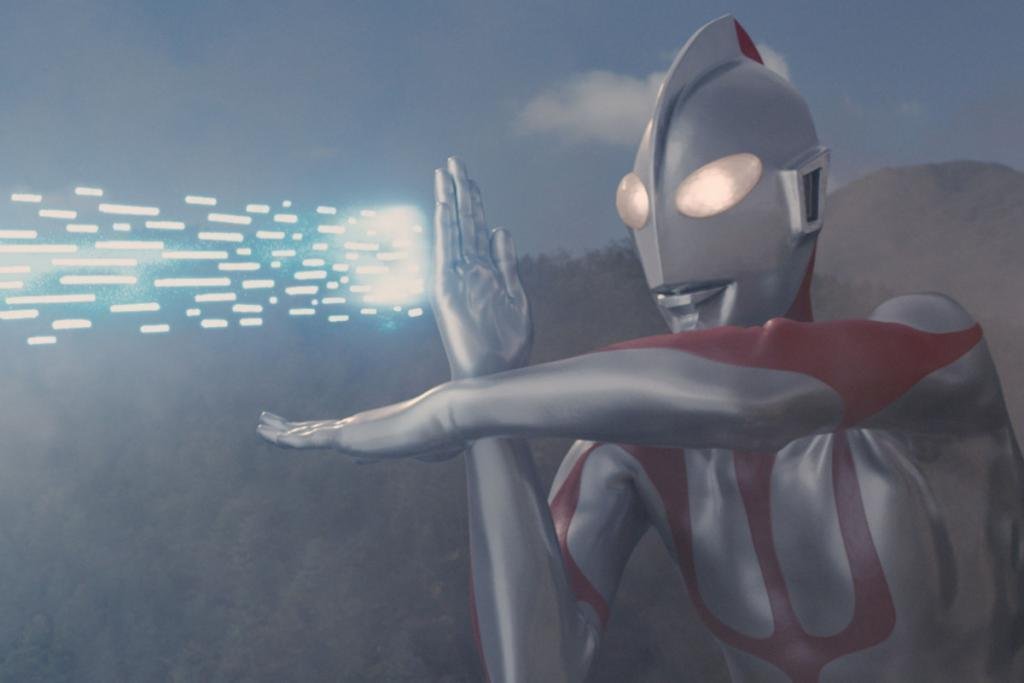
There’s a huge, extensive legacy to consider with the Ultraman franchise as it dates back to 1966, and the question of whether or not a studio can remake a classic property. As a Westerner, I can certainly speak for Hollywood’s intake of IPs whether homegrown or born abroad, and it’s been a rocky ride. With a film like Shin Ultraman, however, I can only ascertain its general success from its current box office reception following its theatrical Japan release back in May, and so to that end, I can only dive into this review as someone relatively new-ish to the franchise apart from my past consumption of Ameritoku and learning of its Super Sentai Origins and other Showa-era materials.
Alas, we get Shin Ultraman, the latest reteam from Hideaki Anno and Shinji Higuchi following their pairing on Anno’s Evangelion projects among others. For both Anno and Higuchi, Shin Ultraman stands as a project that brings both directors full circle, 35 years since Anno’s own Daicon Film-produced college fanfilm, “Return Of Ultraman” garnered audience support, including from Higuchi who attended the film’s 1983 screening. As the man long since charged with developing a trilogy of Ultraman films, Anno’s script now gets shepherded as is with Higuchi at the helm, and with no daunting lack of experience in kaiju cinemafare with the latter having just helmed back-to-back installments of two live-action Attack On Titan films, as well as Shin Godzilla in 2016 with co-helmer Yusuke Ishida.
Much like with what Higuchi and his cohorts did on Shin Godzilla, Shin Ultraman never loses sight of its modus operandi as a visually inherent nostalgia piece, inaugurating this 37th Ultraman film in reboot form with a montage of classic monster attacks leading up to the formation of the Disaster Prevention Agency’s enforcement unit, the SSSP (S-Class Species Suppression Protocol). Counseled by Chief Munakata (Tetsushi Tanaka) and led on the ground by Team Captain Tamura (Hidetoshi Nishijima), the four-member unit successfully manages operations with Japan’s military forces as it battles several subterranean creatures rampaging Japan’s countryside. It’s when the seventh attack occurs that the military’s ordinance seems ineffective that a mysterious object is spotted heading toward Earth. Strategic planning officer and SSSP member Shinji Kaminaga (Takumi Saitoh) spots a child running for cover in the vicinity despite early evacuations, and he sets out to rescue the child just moments before the object crashlands on Earth, creating a deadly shockwave from which a silver humanoid giant appears, confronting the monster and killing it with a single beam, after which Kaminaga, seemingly unscathed, appears from the rubble with the child.
All of this occurs within the first ten minutes or so of the film, ensuing a near-two hour journey of supernatural intrigue and excitement as the newly dubbed hero, “Ultraman”, becomes a regular occurance whenever monsters attack cities. Therein lies the mystique behind Kaminaga, in his burgeoning work relationship with the team’s newest, zesty analyst and Public Security transfer, Hiroko Asami (Masami Nagasawa), who often tries her best to pick Kaminaga’s brain only to flounder from his amicable, albeit somewhat obtuse demeanor. The most interesting part of this is that Kaminaga’s comportment is simply overlooked by Tamura and the rest of his team as characteristic of who he is – somebody who tends to go maverick at times but still serves his purpose on the team efficiently.
There are about nine main kaiju occurrences on Earth, seven of which are the main battle sequences fans can expect in Shin Ultraman. Between each battle and throughout the film, we learn a little more about Kaminaga in relation to the occurrences, while several anomalies begin to appear in an effort to meddle in human affairs so as to manipulate mankind closer to its doom, including using Ultraman’s own Beta technology to their meet sinister ends. The final battle involves a world-destroying machine from Ultraman’s own dimension, which is only one instance of many that boggle the minds of the SSSP’s in-house biologist Yumi Funaberi (Akari Hayami), and especially unparticle physicist, Akihisa Taki (Daiki Arioka) who often finds himself inching closer to his breaking point.
What doesn’t really get fully explained is Kaminaga’s one secret human connection in the wake of the film’s story development with respect to his character as the story unfolds, and it’s a bit of an oversight that’s a little hard to ignore. What we do get in place of these is a briskly-paced and well-written film with some colorful performances, including from actor Koji Yamamoto who plays a quippy quote and catchphrase-loving alien known as Mefilas, as well as from Nagasawa as Asami who has a nice, I’ll say… handy quirk for showing gumption, and we also get to see an even bigger side to her character’s arc – I said what I said.
The film also piggybacks off of one important plot point involving Mefilas to allow its humanist tone to take shape. At this point, Earth is fully at stake thanks to mankind’s exposure to Ultraman and the wills of his enemies, and our hero is forced to choose between the Earth-bound laws of Japan, and the laws of his own multiversal planet which is millions of light years away. Earth’s judgement before a seemingly god-like power plays heavily into Anno’s script, particularly in moments where Japan’s government finds itself being used as a pawn on a really big chessboard, and there’s a funny little philosophical footnote worth paying mind to pertaining to this story point, when Funaberi gets annoyed and swats away a bug from her laptop as she reluctantly accepts yet another mountain location for one of the SSSP’s assignments.
Shin Ultraman is a lean and exquisite, super-sized presentation that blends practical visual effects splendor with an updated touch that doesn’t take away from its throwback fervor, leaving to fans the desired effect as intended. From sleek and improved hero and villain character designs to action set pieces and explosive battle sequences, to an equally synergistic score by composer Shirō Sagisu who has also worked with Higuchi and Anno on past projects, Shin Ultraman might weigh differently for fans of the long-famed Tsuburaya property outside of Japan. However, there’s no question that the film comes from a great place and with good faith, delivering moviegoers alike an impressive display of large scale fanfare that any director would dream of getting to make. Shin Ultraman is a lot of fun, and beyond Anno’s upcoming Shin Kamen Rider, it’s a story that wholly deserves a continuation.
Credit for this review goes in part to our own Edward Orndorff, our biggest authority on all things Tokusatsu and Super Sentai, with whom I consulted a little on Ultraman fandom for this review.
Shin Ultraman was screened as part of the 2022 edition of the New York Asian Film Festival.

